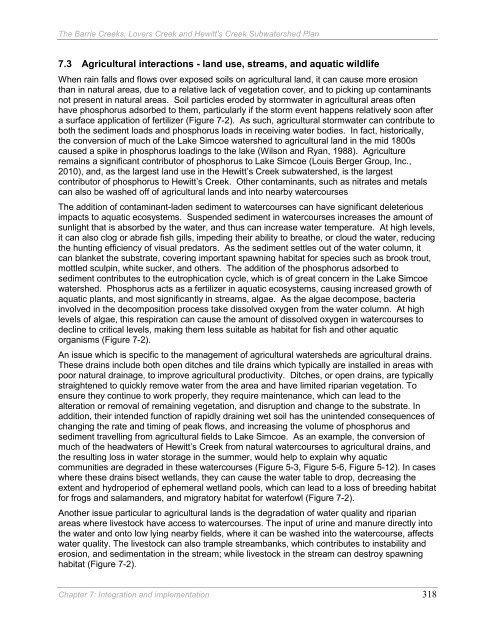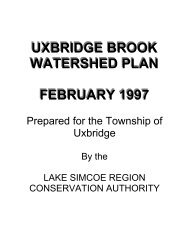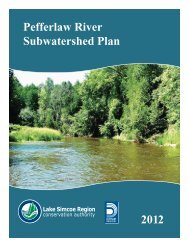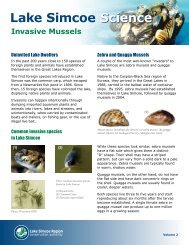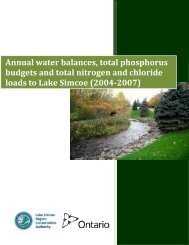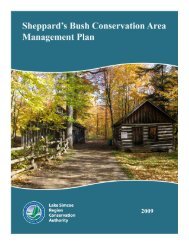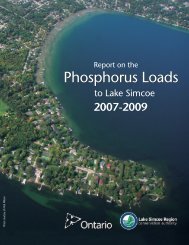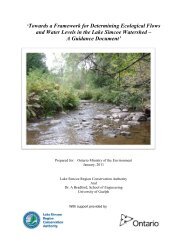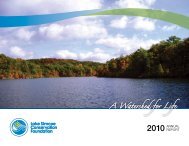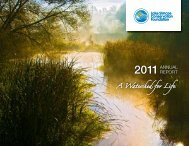Barrie Creeks, Lovers Creek, and Hewitt's Creek Subwatershed Plan
Barrie Creeks, Lovers Creek, and Hewitt's Creek Subwatershed Plan
Barrie Creeks, Lovers Creek, and Hewitt's Creek Subwatershed Plan
Create successful ePaper yourself
Turn your PDF publications into a flip-book with our unique Google optimized e-Paper software.
The <strong>Barrie</strong> <strong><strong>Creek</strong>s</strong>, <strong>Lovers</strong> <strong>Creek</strong> <strong>and</strong> Hewitt’s <strong>Creek</strong> <strong>Subwatershed</strong> <strong>Plan</strong><br />
7.3 Agricultural interactions - l<strong>and</strong> use, streams, <strong>and</strong> aquatic wildlife<br />
When rain falls <strong>and</strong> flows over exposed soils on agricultural l<strong>and</strong>, it can cause more erosion<br />
than in natural areas, due to a relative lack of vegetation cover, <strong>and</strong> to picking up contaminants<br />
not present in natural areas. Soil particles eroded by stormwater in agricultural areas often<br />
have phosphorus adsorbed to them, particularly if the storm event happens relatively soon after<br />
a surface application of fertilizer (Figure 7-2). As such, agricultural stormwater can contribute to<br />
both the sediment loads <strong>and</strong> phosphorus loads in receiving water bodies. In fact, historically,<br />
the conversion of much of the Lake Simcoe watershed to agricultural l<strong>and</strong> in the mid 1800s<br />
caused a spike in phosphorus loadings to the lake (Wilson <strong>and</strong> Ryan, 1988). Agriculture<br />
remains a significant contributor of phosphorus to Lake Simcoe (Louis Berger Group, Inc.,<br />
2010), <strong>and</strong>, as the largest l<strong>and</strong> use in the Hewitt’s <strong>Creek</strong> subwatershed, is the largest<br />
contributor of phosphorus to Hewitt’s <strong>Creek</strong>. Other contaminants, such as nitrates <strong>and</strong> metals<br />
can also be washed off of agricultural l<strong>and</strong>s <strong>and</strong> into nearby watercourses<br />
The addition of contaminant-laden sediment to watercourses can have significant deleterious<br />
impacts to aquatic ecosystems. Suspended sediment in watercourses increases the amount of<br />
sunlight that is absorbed by the water, <strong>and</strong> thus can increase water temperature. At high levels,<br />
it can also clog or abrade fish gills, impeding their ability to breathe, or cloud the water, reducing<br />
the hunting efficiency of visual predators. As the sediment settles out of the water column, it<br />
can blanket the substrate, covering important spawning habitat for species such as brook trout,<br />
mottled sculpin, white sucker, <strong>and</strong> others. The addition of the phosphorus adsorbed to<br />
sediment contributes to the eutrophication cycle, which is of great concern in the Lake Simcoe<br />
watershed. Phosphorus acts as a fertilizer in aquatic ecosystems, causing increased growth of<br />
aquatic plants, <strong>and</strong> most significantly in streams, algae. As the algae decompose, bacteria<br />
involved in the decomposition process take dissolved oxygen from the water column. At high<br />
levels of algae, this respiration can cause the amount of dissolved oxygen in watercourses to<br />
decline to critical levels, making them less suitable as habitat for fish <strong>and</strong> other aquatic<br />
organisms (Figure 7-2).<br />
An issue which is specific to the management of agricultural watersheds are agricultural drains.<br />
These drains include both open ditches <strong>and</strong> tile drains which typically are installed in areas with<br />
poor natural drainage, to improve agricultural productivity. Ditches, or open drains, are typically<br />
straightened to quickly remove water from the area <strong>and</strong> have limited riparian vegetation. To<br />
ensure they continue to work properly, they require maintenance, which can lead to the<br />
alteration or removal of remaining vegetation, <strong>and</strong> disruption <strong>and</strong> change to the substrate. In<br />
addition, their intended function of rapidly draining wet soil has the unintended consequences of<br />
changing the rate <strong>and</strong> timing of peak flows, <strong>and</strong> increasing the volume of phosphorus <strong>and</strong><br />
sediment travelling from agricultural fields to Lake Simcoe. As an example, the conversion of<br />
much of the headwaters of Hewitt’s <strong>Creek</strong> from natural watercourses to agricultural drains, <strong>and</strong><br />
the resulting loss in water storage in the summer, would help to explain why aquatic<br />
communities are degraded in these watercourses (Figure 5-3, Figure 5-6, Figure 5-12). In cases<br />
where these drains bisect wetl<strong>and</strong>s, they can cause the water table to drop, decreasing the<br />
extent <strong>and</strong> hydroperiod of ephemeral wetl<strong>and</strong> pools, which can lead to a loss of breeding habitat<br />
for frogs <strong>and</strong> salam<strong>and</strong>ers, <strong>and</strong> migratory habitat for waterfowl (Figure 7-2).<br />
Another issue particular to agricultural l<strong>and</strong>s is the degradation of water quality <strong>and</strong> riparian<br />
areas where livestock have access to watercourses. The input of urine <strong>and</strong> manure directly into<br />
the water <strong>and</strong> onto low lying nearby fields, where it can be washed into the watercourse, affects<br />
water quality. The livestock can also trample streambanks, which contributes to instability <strong>and</strong><br />
erosion, <strong>and</strong> sedimentation in the stream; while livestock in the stream can destroy spawning<br />
habitat (Figure 7-2).<br />
Chapter 7: Integration <strong>and</strong> implementation 318


